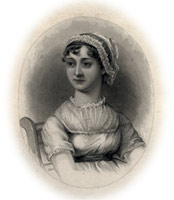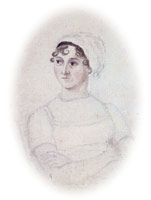It is said that Jane Austen lived a quiet life. Only a few of her manuscripts remain in existence and the majority of her correspondence was either burned or heavily edited by her sister, Cassandra, shortly before she died. As a result, the details that are known about her are rare and inconsistent. What can be surmised through remaining letters and personal acquaintances is that she was a woman of stature, humor and keen intelligence. Family remembrances of Austen portray her in a kind, almost saintly light, but critics who have studied her books and the remnants of her letters believe she was sharper than her family wished the public to think.
Jane Austen was born in Steventon, Hampshire on December 16, 1775 and grew up in a tight-knit family. She was the seventh of eight children, with six brothers and one sister. Her parents, George Austen and Cassandra Leigh, were married in 1764. Her father was an orphan but with the help of a rich uncle he attended school and was ordained by the Church of England. Subsequently, he was elevated enough in social standing to provide Cassandra a worthy match whose family was of a considerably higher social status. In 1765, they moved to Steventon, a village in north Hampshire, about 60 miles southwest of London, where her father was appointed rector.
Like their father, two of Austen’s older brothers, James and Henry, were ordained and spent most of their lives in the Church of England. Of all her brothers, Austen was closest to Henry; he served as her agent, and then after her death, as her biographer. George, the second oldest son, was born mentally deficient and spent the majority of his life in institutions. The third son, Edward, was adopted by their father’s wealthy cousin, Thomas Knight, and eventually inherited the Knight estate in Chawton, where Austen would later complete most of her novels. Cassandra, Austen’s only sister, was born in 1773. Austen and Cassandra were close friends and companions throughout their entire lives. It is through the remaining letters to Cassandra that biographers are able to piece Austen’s life together. The two youngest Austen boys, Francis and Charles, both served in the Navy as highly decorated admirals.
When Austen was 7, she and Cassandra were sent to Oxford to attend school but sometime later the girls came down with typhus and were brought back to Steventon. When Austen was 9 they attended the Abbey School in Reading. Shortly after enrolling however, the girls were withdrawn, because their father could no longer afford tuition. Though this completed their formal schooling, the girls continued their education at home, with the help of their brothers and father.
The Austens often read aloud to one another. This evolved into short theatrical performances that Austen had a hand in composing. The Austen family plays were performed in their barn and were attended by family members and a few close neighbors. By the age of 12, Austen was writing for herself as well as for her family. She wrote poems and several parodies of the dramatic fiction that was popular at the time, such as History of England and Love and Freindship [sic]. She then compiled and titled them: Volume the First, Volume the Second and Volume the Third.
Austen is said to have looked like her brother Henry, with bright hazel eyes and curly hair, over which she always wore a cap. She won the attention of a young Irish gentleman named Tom Lefroy. Unfortunately, Lefroy was in a position that required him to marry into money. He later married an heiress and became a prominent political figure in Ireland.
In 1795, when she was 20, Austen entered a productive phase and created what was later referred to as her “First Trilogy.” Prompted by increasing social engagements and flirtations, she began writing Elinor and Marianne, a novel in letters, which would eventually be reworked and retitled Sense and Sensibility. The following year, she wrote First Impressions, which was rejected by a publisher in 1797. It was the first version of Pride and Prejudice. She began another novel in 1798, titled Susan, which evolved into Northanger Abbey.
The Austens lived happily in Steventon until 1801, when her father suddenly announced he was moving the family to Bath. Austen was unhappy with the news. At the time, Bath was a resort town for the nearly wealthy with many gossips and social climbers. As they traveled that summer, however, she fell in love with a young clergyman who promised to meet them at the end of their journey. Several months later he fell ill and died.
Bath was difficult for Austen. She started but did not finish The Watsons and had a hard time adjusting to social demands. She accepted a marriage proposal from Harris Bigg-Wither, the son of an old family friend, but changed her mind the next day. A few years later, in 1805, her father died, leaving Jane, Cassandra and their mother without enough money to live comfortably. As a result, the Austen women relied on the hospitality of friends and family until they were permanently relocated to a cottage in Chawton, Hampshire, belonging to her brother Edward Austen-Knight. There, Austen began the most productive period of her life, publishing several books and completing her “Second Trilogy.”
Austen finished the final drafts of Sense and Sensibility and Pride and Prejudice in 1811. They were published shortly after and she immediately set to work on Mansfield Park. In 1814, Mansfield Park was published and Emma was started. By this time, Austen was gaining some recognition for her writing, despite the fact that neither Sense and Sensibility or Pride and Prejudice were published under her name.
Austen began showing symptoms of illness while she worked on Persuasion, her last completed novel. It was published with Northanger Abbey after her death. Unknown at the time, Austen most likely suffered from Addison’s disease, whose symptoms include fever, back pain, nausea and irregular skin pigmentation. On her deathbed, when asked by her sister Cassandra if there was anything she required, she requested only “death itself.” She died at the age of 41 on July 18, 1817 with her sister at her side.
Jane Austen’s Enduring Popularity
When asked why Jane Austen’s works are so popular, Richard Jenkyns, author of A Fine Brush on Ivory: An Appreciation of Jane Austen and descendant of Austen’s older brother, said: “I don’t think it’s nostalgia for the past and all those empire-line dresses and britches tight on the thigh, all that sort of thing. I guess that she is popular because she is modern… I think her popularity is in her representing a world, in its most important aspects, that we know.”
Although living in a world that seems remote in time and place, Jane Austen’s characters have experiences and emotions that are familiar to us. They misjudge people based on appearances, they’re embarrassed by their parents, they flirt and they fall in love. Her characters face social restrictions that can be translated into any environment, from a California high school in Clueless to an interracial romance in Bride and Prejudice. The critical and commercial success of the numerous recent film and television adaptations of Jane Austen’s novels, including nine of Pride and Prejudice, testifies to her timeless and universal appeal. Yet they fail to fully capture the genius of her writing. She was a great writer, a sharp wit and a wonderful satirist.
Takeoffs of Austen’s work, such as Helen Fielding’s Bridget Jones’s Diary and Clueless, have been huge successes. A number of sequels to Pride and Prejudice have been written such as Lady Catherine’s Necklace by Joan Aiken; Mr. Darcy’s Daughters by Elizabeth Aston; and Pemberley: or Pride and Prejudice Continued by Emma Tennant. Other novels such as Karen Joy Fowler’s The Jane Austen Book Club and Kate Fenton’s Vanity and Vexation: A Novel of Pride and Prejudice have contemporary settings using Austen’s characters or plots.
In The Eye of the Story, Eudora Welty wrote that Austen’s novels withstand time because “they pertain not to the outside world but to the interior, to what goes on perpetually in the mind and heart.” Perhaps, for these reasons, Austen’s work continues to fascinate, entertain and inspire us.
Sources
- Tucker, George Holbert. Jane Austen the Woman. St. Martin’s Press, 1994.
- Laski, Marghanita. Jane Austen and Her World. Charles Scribner’s Sons, 1975.
- “Jane Austen.” Concise Dictionary of British Literary Biography, Volume 3: Writers of the Romantic Period, 1789-1832. Gale Research, 1992.
Content last updated: October 31, 2005


